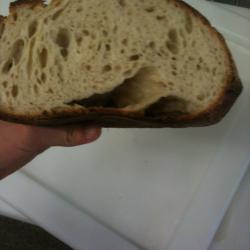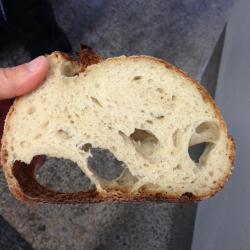
Please help. Any suggestions would be appreciated.
We've been having this problem, having big holes in sourdough, for a while now. This problem seems to occur only in plain sourdough, but not any other type of sourdough (i.e. wholemeal sourdough, sourdough with grains or any other added ingredients.). Often crumb seems to come off the crust on the bottom as you can see from the picture. Not every loaf is like this or as bad as this but we quite often find loaves similar to this (usually, the size of the hole is about a half of what you can see in the picture).
We feed our culture with unbleached flour from Wholegrain Milling (NSW Australia). We use both liquid and stiff leaven. We mix the dough in the morning, then rest it for a few hours, scale, rest, shape, retard overnight and then bake off the next morning.
We've tried a few things to solve this issue. We've tried changing the amount of gluten, hydration, humidity/temperature of retarder-prover, oven temperature and shaping method but none of them has worked out. I'm running out of the solutions.
Has anybody had the same or similar problem to this before? Please give me some ideas to solve this problem...
Thanks.


Replies
My first thought would be its a loaf forming issue but baking temps could play a roll too I would think. Maybe too hot.
just some thoughts
suggestion could be on the money. Possibly if you have too much flour on the bench when shaping the dough layers do not seal together leaving a giant air pocket that then expands and separates in a big way. The fault is concentrated on the bottom of the loaf as that is where the seal normally is.
Not sure why it might be limited to one type of bread unless the hydration is markedly lower or something that could also inhibit the healing characteristics of the dough when it is formed into a loaf.
So I think the first move might be to concentrate on your loaf forming technique and see if that improves the situation.
Let us know how you go.
Farinam
We would see this and a variety of these types of blisters and holes in our sourdough from time to time in our bakery. There are a number of different causes, but on this one it looks as though you may have had too much flour on the bench and perhaps created a blister while kneading. Or it is under-kneaded.
The other thing I would look at is that you may have touched the loaf in that area after the dough had proofed right before going into the oven.
Now that I have taken a closer look at the pic you can see that the grain of the loaf seems to revolve around the blister. I believe that this was caused during the kneading process and a blister was created and not worked out.
Thanks guys for all the suggestions.
Firstly, I doubt that it's a shaping issue. I learnt really good shaping skills at my previous workplace and I've had no problem like this back then. If anything, I am possibly shaping too tight, for this dough; there could be too much tention inside the loaf and breaking down the structure, I don't really know but I doubt it. Also, I don't think I'm using excess flour when I shape.
With regards to baking temperature, we reduced it, but it probably sounds still high to some people. We used to bake at 250 degrees celsius (482 F), which I thought was way too high, so I reduced it to 235 degrees celsius (455 F). We use electric deck ovens and bake straight on the stones. My boss likes the bread in quite dark colour, so I don't think I can reduce the temperature any further; I could reduce the temperature and bake longer, but then the crumb will dry out too much.
I proof the dough upside down on couche mats, so I definitely touch the proofed dough before they go into the oven, but this is the same as any other bakeries where they use couche mats?
Doctor. Young, with regards to "during the kneading process", you mean "mixing process" or "shaping process"? Sorry, I'm a little bit confused...I assume that it's the shaping process. If it is, then am I not degassing properly?
Forgot to mention but the holes can be seen only in plain sourdough loaves (800g); we also make sourdough baguettes out of the same dough but I don't think there are any big holes in the baguettes for some reason. Maybe something is happening while we shape the sourdough loaves...? Well, the baguettes naturally don't get as much oven springs anyway...
I also used to think that we may not be proving the dough enough (after retarding the dough, at final proof stage) but I realised that holes come up even if I prove them much longer unless we really overprove them - then get flat loaves.
We make sourdough with quite a high percentage of leaven - 50% stiff leaven plus some liquid leaven as well. I am aware that this is way too much, but the fermentation process is under control since we put more salt in than other bakeries would with 30% stiff leaven.
Probably way off course, but is there some part of the handling process between getting the proofed loaves off the mats and onto the peel (or even in the way they are slid off the peel) that causes any shear stress between that bottom skin and the bulk of the loaf? I only note this because I have at times had an issue when loaves have gotten a bit sticky in the banettons, where the loaf "hangs" a little by its upper skin before it drops out, and this causes shearing under the top skin, resulting in big bubbles under the upper skin.
Thiis may have nothing to do with it, but I imagine if there is some fairly regular part of the handling process with the ripe loaves that leads to stress within the dough towards the bottom, the same thing could occur in that part of the loaf. (For instance, you roll the ripe loaf off, but it kind of sags while you get under it, while you hold it by it's bottom skin, and before you drop onto the peel. Or you really vigorously slide off the peel and it hits rough bricks, and the intertia of the loaf works against the friction on the lower skin to cause some shear inside lower part of the loaf.) Just a wild guess, and as I say probably wrong, but anyways...
Hello,
first at all axcuse me for my bad english; I am a german baker living in France and I had the same problem. Unsatisfied with my bread I changed temperatures, schedules, flour, oven and anything imaginable, and at the end even my sourdough. I changed meant I started a new one.
But last weekend I visited a baker friend and qhe said for sur it is your sourdough, here you can have a piece of mine. So I tried and she had been right. Not a hole in all my loafs, well baken bread with regular littles alveoles.
These were pretty good looking loaves (though the edges of the ears are a little singed) coming out of the oven with nice crispy crusts. But when cooled and I cut into the first one (on the left) I was totally bummed by the large holes and dense crumb. The other loaf wasn't quite so bad. I used a levain made with a nice active sourdough starter. For dough I used 750 grams bread flour and 250 grams spelt/rye flour blend, 700 grams water, 20 grams salt and a ripe levain made with 25 grams starter, 100 grams each water and bread flour. Did an autolyse of 30 minutes (with levain but no salt til after autolyse). Did bulk proof at 72-73F for about 4 hours but forgot to check the internal temp before starting shaping steps. Did pretty rigorous slap and folds for about 8 minutes then two sets of stretch and folds 30 minutes apart. Achieved a nice window pane effect so then shaped into batards, placed in bannetons, did a final braid in the bannetons after a 20 minute rest (which was different from my usual). Then a cold ferment in fridge for about 14 hours. Baked in Dutch ovens with oven set at 485F. Preheated oven and dutch ovens for an hour or so. I baked both loaves at the same time in a 2/3 size oven (lower oven in a double oven set). My concern is that the oven temp drops so much when I put the loaves in and then never seems to recover full temp. But how do you get around that? Maybe I should bake only one loaf at a time? I also have a large gas oven which I usually use but have had temp control issues with it, too, so thought I'd try the smaller electric oven which I thought would recover more quickly--which it did, jut not fully). I use both an analog and a digital thermometer trying to figure out my temperature issues.
My suspicion is that I'm not shaping quite right or I have oven temperature control issues.
I appreciate your thoughts.
Frustrated in Poulsbo, WA,
Patsy
P.S. this is my first time asking for online help with anything. I started out my sourdough journey with some pretty good luck but lately have been having issues. Hopefully just a slump...